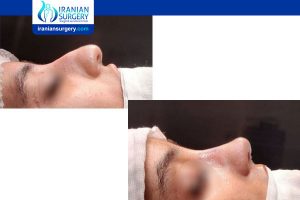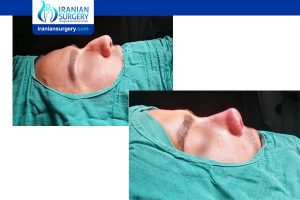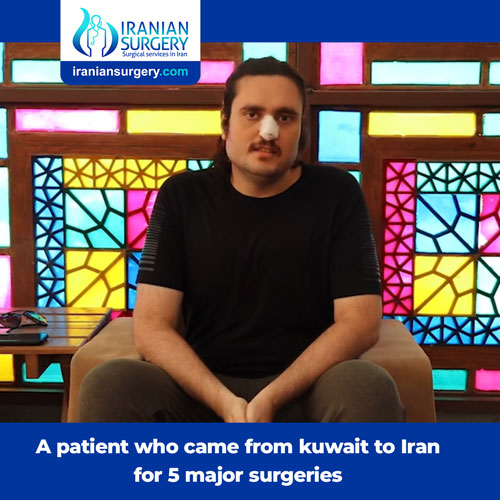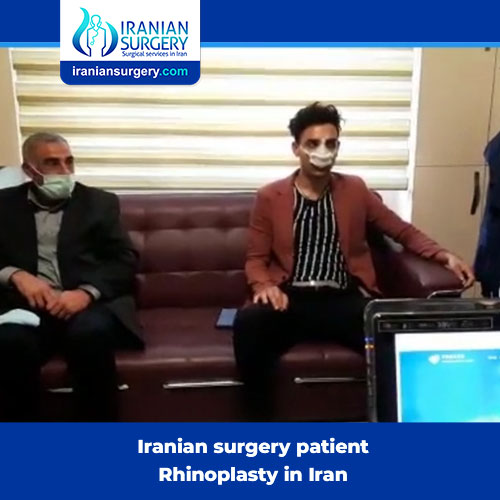Closed Rhinoplasty

Closed Rhinoplasty Surgery
How much does closed rhinoplasty cost?
What is Closed Rhinoplasty?
Closed rhinoplasty cost and revision close rhinoplasty in Iran is about $ 1400 ,which includes closed rhinoplasty surgery, anesthesia, Pre op tests and the cost of a doctor’s visit before and after surgery.
A closed rhinoplasty is the most common type of rhinoplasty. All incisions are hidden inside the nose with no external scars. Lifting the soft tissue slightly upward, the bone and cartilage is accessible to perform the necessary changes.
Closed rhinoplasty is suitable for any type of nose surgery depending on the surgeon’s skill. If this is your first operation, closed rhinoplasty is likely to be recommended. Closed rhinoplasty is an effective method for patients who are opting for simple surgery to thin the nose or remove lumps or bumps, rather than having work done on the tip. Moreover, closed rhinoplasty is suitable for those who need small changes to their nose and want to heal faster.

Read more about : How much does rhinoplasty cost in Iran?
Read more about : Revision rhinoplasty in Iran
Read more about : Rhinoplasty in Iran before and after
Read more about : Rhinoplasty podcast with Dr Afshan shah
Read more about : Revision Rhinoplasty podcast with Dr Afshan shah
Read more about : Rhinoplasty in Iran Review
Read more about : Ethnic Rhinoplasty in Iran
Before Closed Rhioplasty
Preparing for Closed rhinoplasty
Before scheduling closed rhinoplasty in Iran, you should send your medical records to rhinoplasty surgeon in Iran. The most important question your doctor will definitely ask you is about your motivation and goals of surgery. Your doctor will also ask questions about your medical history — including a history of nasal obstruction, surgeries and any medications you take. If you have a bleeding disorder, such as hemophilia, you may not be a proper candidate for nose job surgery in Iran.
Read more about : Open rhinoplasty
Read more about : Difference between open and closed rhinoplasty
What important factors should I notice before doing closed Rhinoplasty in Iran?
- Get lab. It is important that we ensure our patients are healthy enough to have surgery so we should ask our patients to have a hemoglobin test.
- Take certain medications or adjust your current medications.
- Stop smoking 2 weeks before and after surgery.
- Avoid taking aspirin, anti-inflammatory drugs and herbal supplements as they can increase bleeding.
- Limit sun exposure for 2 weeks
- Do need eat or drink anything 6 hours prior
- Purchase all recovery items beforehand
What are the Advantages of closed rhinoplasty?
. Closed rhinoplasty is less invasive and leaves no scars and less swelling and bruising after surgery, so there will be a shorter recovery time and downtime.
. Closed rhinoplasty procedure takes a shorter time to be completed that open rhinoplasty does.
. Reduced nasal tissue irritation (due to the lack of a columellar incision)
. Reduced likelihood of the nasal-tip support reduction
. Smaller likelihood of post-operative edema
Read more about : Nose job simulator
What are the Disadvantages of closed rhinoplasty?
. As there is limited visibility of the tissues and cartilage, the surgeon can make limited changes, with less delicacy.
. There are fewer surgeons who are skillful at closed rhinoplasty than open rhinoplasty.
. Incisions made in the nose weaken the nasal structure, undermining the stability of the shape of the nose in the future.
. There is a higher chance of nasal cartilage distortion during the operation as accessing the nasal framework requires intense stretching of the skin.
Read more about : Open rhinoplasty vs closed rhinoplasty
Am I a Good Candidate for Closed Rhinoplasty?
Good candidates for closed rhinoplasty include:
. The best candidate for closed rhinoplasty is someone who requires minor work — the removal of a dorsal hump, for instance — but whose nose tip and overall structure of the nose is good.
. An ideal patient for closed rhinoplasty is someone who wants to make changes to the nasal dorsum, the nasal side walls and some minor changes to the nasal tip.
. An ideal closed rhinoplasty patient hasn’t had a lot of nasal trauma or previous surgery.
. Closed rhinoplasty candidates are people with a bridge or bulbous tip on their nose or someone with breathing issues because of the structure of the nose.
Read more about : Bulbous nose surgery
Risks and Complications
Closed rhinoplasty is a safe surgical procedure with a high satisfaction rate if performed by a qualified plastic surgeon. However, there is always the possibility that complications or unwanted results may appear.
The risks of closed rhinoplasty include:
. Bruising
. Swelling
. Scarring
. Asymmetry
. Numbness
. Hematoma – Blood collecting under the skin
. Breathing difficulties
. Burst blood vessels
. Possibility of revisional surgery
During Closed Rhinoplasty
How is Closed Rhinoplasty performed?
Closed rhinoplasties are done as an alternative to the open technique. Instead of exposing the nasal structure, incisions are made on the nasal membrane in varying locations to access different parts of the nose framework. By not opening the nose, patients are able to have reduced recovery times and non-visible scars. Whatever your goals may be, whether for an ethnic rhinoplasty or rejuvenation nose job, a closed technique can most likely be utilized.
During a closed rhinoplasty, incisions will be made on the inside of the nose. The nasal structure will not be exposed which means decreased visualization for the surgeon, however postoperative scarring will be hidden and discreet. The addition of an endoscope may be used during a closed rhinoplasty to increase visualization. When repair has been completed, sutures will close incisions and an external splint or cast will be placed over the nose.
The goal of a closed rhinoplasty is to achieve facial harmony by changing the shape, size or angle of the nose. Closed rhinoplasty can also be used to correct breathing problems resulting from irregularities inside the nose.
After Closed Rhinoplasty
Recovery
Since closed nose surgery is less invasive than the open method, there will be less swelling and bruising after this surgery and the nose will heal faster. There might even be no bruising after closed rhinoplasty in some patients. Therefore, the recovery time in closed rhinoplasty is shorter than in open rhinoplasty and patients usually need a shorter time to be able to return to their normal life.
The full results of a closed rhinoplasty become visible within approximately one to two years of treatment because it takes this long for all of the swelling to go away completely. However, downtime after a closed or open rhinoplasty generally lasts about two weeks. A nose splint is typically removed within five to six days of a closed rhinoplasty procedure. At this point, post-rhinoplasty bruising and swelling is usually minimal, too.
Flying after Closed rhinoplasty
A patient must not fly for at least 5 days after the surgery. While unlikely, the possibility that you will have a nosebleed during the flight, which could be an emergency situation, is avoided. It is still not recommended to fly for an additional week (in total 2 weeks), but many patients cannot stay in town for that long of a period. If you must fly during the second week of your recovery, it is important to take Sudafed and spray a nasal decongestant (Afrin or other) prior to taking off. If not, the pressure changes during the flight may be very painful. It is also typical to have renewed swelling after the flight, which will last about 1-2 days. All of these issues are not concerning if you are planning to travel by car or train.
Out of town patients should plan to stay a few days after the surgery at a hotel. They can travel and fly back home after splint removal at 5-7 days. Physical activity should be limited for 10-14 days. It usually takes about 6 weeks before the patient can exercise again without discomfort. High-risk contact sports should be avoided for 3 months.
How can I clean my nose after Closed Rhinoplasty in Iran?
4 Ways to clean your nose after Closed Rhinoplasty are as follows:
. Q-tip and hydrogen peroxide
. Saline rinse
. Removing blockages
. Use a moist towelette
The cost of Closed Rhinoplasty in Iran is about $ 1400.
- Rhinoplasty in Iran
- Rhinoplasty in Iran cost
- Revision Rhinoplasty in Iran
- Closed Rhinoplasty in Iran
- Open Rhinoplasty in Iran
- Before Rhinoplasty in Iran
- During Rhinoplasty in Iran
- After Rhinoplasty in Iran
- The common methods used in rhinoplasty in Iran
- Flying after Rhinoplasty in Iran
- Risks of Rhinoplasty in Iran
- Steps of Rhinoplasty in Iran
- Cleaning outside of nose after Rhinoplasty in Iran
- Best age for Rhinoplasty surgery
- Rhinoplasty Recovery
- Features of a good Rhinoplasty surgery in Iran
- Infective complications related to Rhinoplasty surgery
- Plastic surgery in Iran
- Rhinoplasty
- Face lift
- Facial plastic surgery
- Lip augmentation
- Ear pinning
- Blepharoplasty
- Neck lift surgery
- Chin lift surgery
- Liposuction
- Abdominoplasty (tummy tuck)
- Body sculpting
- Arm Lift
- Brazilian Butt Lift
- Breast Augmentation
- Breast Lift
- Breast implant
- male breast reduction ( gynecomastia )
- sex reassignment surgery ( sex change )
- Vaginoplasty
- labiaplasty
- Hair transplant for male
- Female hair transplant
- Reconstructive surgery
- Septoplasty
- Breast reconstruction
- Breast reduction
- Cleft lip and palate repair






